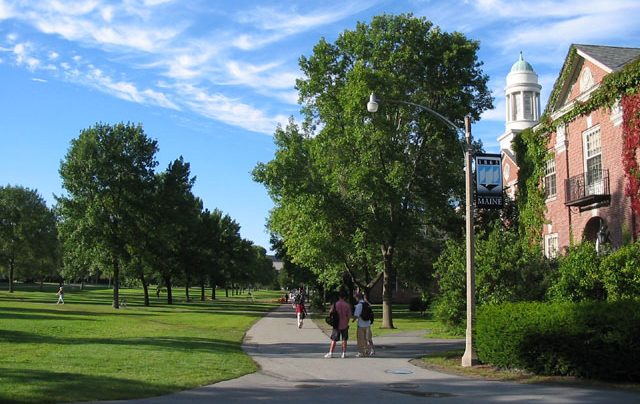Access to a college education remains the best way for Mainers to boost their earnings and economic well-being. Yet too often, the cost of college remains a barrier to completion or even attendance. A bill before the Maine Legislature, LD 1368, would help close the affordability gap for many Maine students.
Cost is an obstacle that stops many Mainers from earning a college degree. This barrier is particularly hard to overcome for the Mainers who would most benefit from a college education — people of color, those who are the first in their family to go to college, or those who are from families with low incomes. When college is unaffordable, many of these Mainers don’t earn the degree or certificate that could improve job prospects and income.
Colleges use a calculation known as the “Expected Family Contribution,” or EFC, to determine how much money an incoming student or their family should be expected to be able to pay to cover the cost of college. The EFC is a big factor in determining how much financial aid a student receives. In simplest terms, the EFC is subtracted from the total cost of attendance, and a financial aid package — including low-interest, fixed rate federal Stafford loans, grants and work study — is crafted for the student to cover the rest.
In reality, though, the EFC for many families is an abstract figure that doesn’t accurately represent their ability to pay. In 2014, a legislative task force on college affordability identified an “affordability gap” of $17,000 over the course of a four-year degree for a low-income student at a Maine public university.[i] That’s $17,000 even after accounting for subsidized federal loans, Pell grants, working 15 hours a week, and the existing State of Maine grant. In other words, a student can tap into all the reasonable resources available and still face a shortfall.
Such shortfalls are commonly filled with private student loans. These loans have higher interest rates than federal Stafford loans and haunt college graduates for years after getting their degree. And Americans are increasingly resorting to private loans. In 2017-18, U.S. students borrowed $11.6 billion in private loans, twice as much, in real terms, as they borrowed in 1997-98.[ii] Americans now owe more than $1.5 trillion in student loan debt,[iii] with one in five Mainers having student debt totaling $6 billion altogether.[iv]
Students don’t need to clear the hurdle of high college costs just once. They must clear it every year of their studies. Many students who successfully enroll in higher education end up dropping out later for financial reasons. Today, one-fifth of Maine adults have some college education, but no degree.[v]
LD 1368 would require colleges in Maine to cover students’ EFCs, effectively limiting their debt exposure to federally backed Stafford loans only. This means asking private schools to make use of their large endowments and increasing our commitment to public education as a state. Where there is a cost to the public system, investment in education today will pay dividends for Maine families and our economy. One estimate suggests every state government dollar spent on public higher education in Maine produces $2.90 in increased tax revenues and reduced safety-net costs.[vi]
Student loan debt acts as a drag on the economy by reducing the ability of borrowers to fully participate in it. Large student loan burdens delay or prevent them from starting a business, buying a home, or starting a family.[vii] The debt has persistent impacts on the everyday finances of Mainers. A poll commissioned by MECEP in December 2018 found Mainers struggling to pay student loans in multiple ways:[viii]
- 60 percent of respondents said they’ve struggled to pay a student loan payment.
- 56 percent of respondents said that student loan debt is causing them to reduce the amount they save for retirement.
- 51 percent of respondents said that they had to delay a major purchase like a car.
- 39 percent had to skip a bill in order to pay their loans, including a utility bill, rent, or car payment.
- More than 40 percent of respondents know someone who moved to another state in order to take a job that will help them afford payments.
- One in three Maine student loan borrowers have been unable to buy necessities such as food and clothing in order to make their loan payments.
By covering the expected family contribution, LD 1368 would lower the cost barrier that keeps so many students from attending or finishing college, and it would reduce the overall student debt burden on future generations of students, so that they can more fully participate in our economy. That’s well worth the cost.
Notes
[i] “Final Report of the Commission to Study College Affordability and College Completion,” Dec 9, 2014. Available at https://www.maine.gov/legis/opla/CollegeAffordabilityFinalReport.pdf
[ii] MECEP analysis of “Trends in Student Aid,” The College Board. Web. Available at https://trends.collegeboard.org/student-aid/figures-tables/total-federal-and-nonfederal-loans-over-time. In the 1997-98 school year, college students borrowed $3.5 billion in private loans, equivalent to $5.4 billion after adjusting for inflation.
[iii] Federal Reserve Bank of New York, Quarterly Report on Household Credit and Debt, Q4 2018. Available at https://www.newyorkfed.org/medialibrary/interactives/householdcredit/data/pdf/HHDC_2018Q4.pdf
[iv] Jody Harris, “Policy Brief: Predatory actors worsen borrowers’ woes as education debt holds back Maine’s economy,” Maine Center for Economic Policy, Dec 10, 2018. Web. Available at https://www.mecep.org/policy-brief-predatory-actors-worsen-borrowers-woes-as-education-debt-holds-back-maines-economy/
[v] US Census Bureau, American Community Survey, 2017 data. 19% of Mainers aged 25 and older had some college education but no degree.
[vi] Philip Trostsel, “The Fiscal Impacts of College Attainment,” Federal Reserve Bank of Boston, 2007. Web. Available at https://www.bostonfed.org/publications/new-england-public-policy-center-working-paper/2007/the-fiscal-impacts-of-college-attainment.aspx
[vii] Rajashri Chakrabarti, Nicole Gorton, and Wilbert van der Klaauw, “Diplomas to Doorsteps: Education, Student Debt, and Homeownership,” Federal Reserve Bank of New York, Apr 3, 2017. Web. Available at https://libertystreeteconomics.newyorkfed.org/2017/04/diplomas-to-doorsteps-education-student-debt-and-homeownership.html
[viii] “New poll: Mainers struggle to pay down student debt, say loan servicers are making matters worse,” Maine Center for Economic Policy, Nov 29, 2018. Web. Available at https://www.mecep.org/new-poll-mainers-struggle-to-pay-down-student-debt-say-loan-servicers-are-making-matters-worse/




